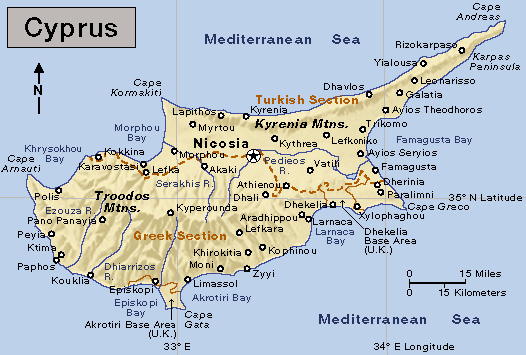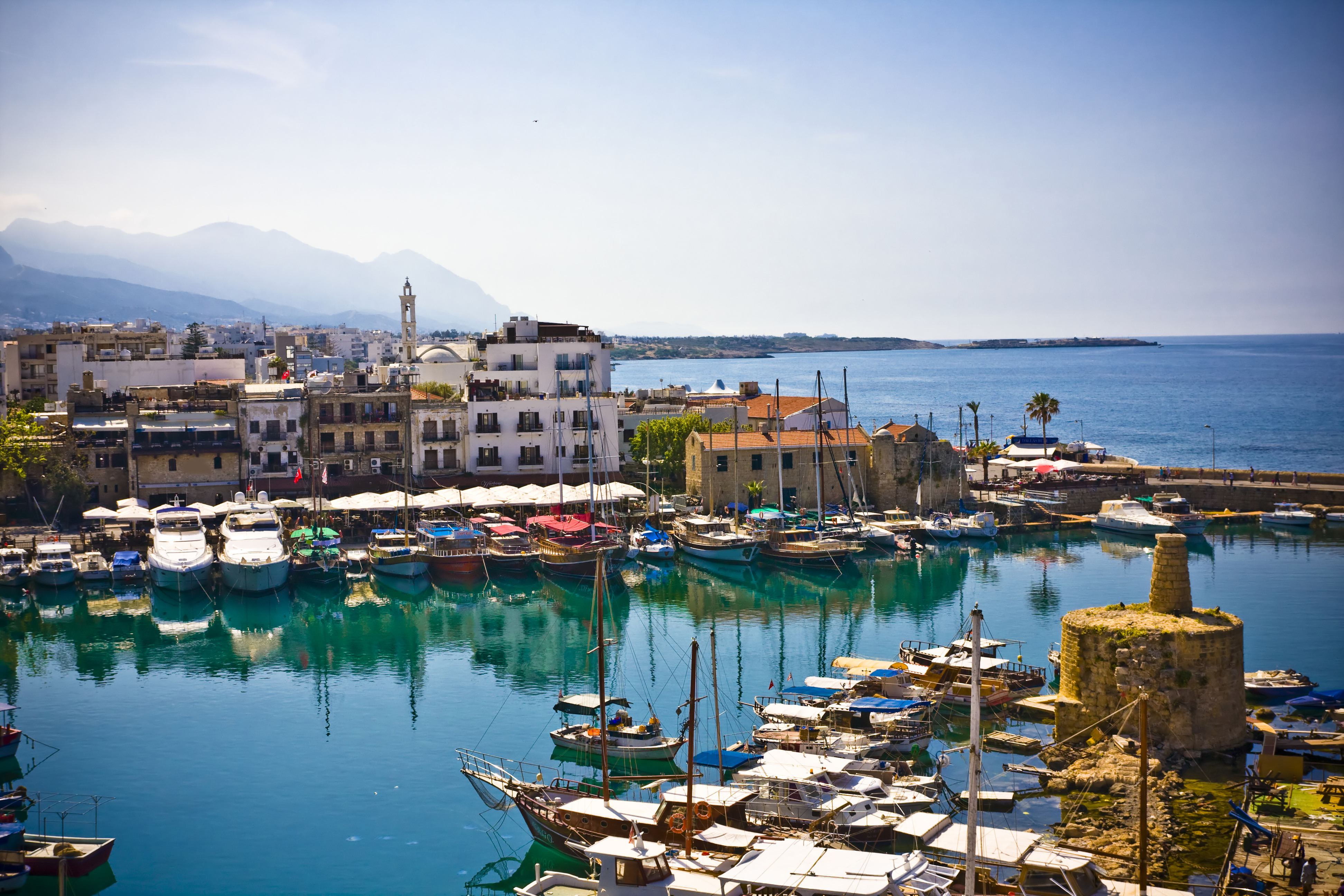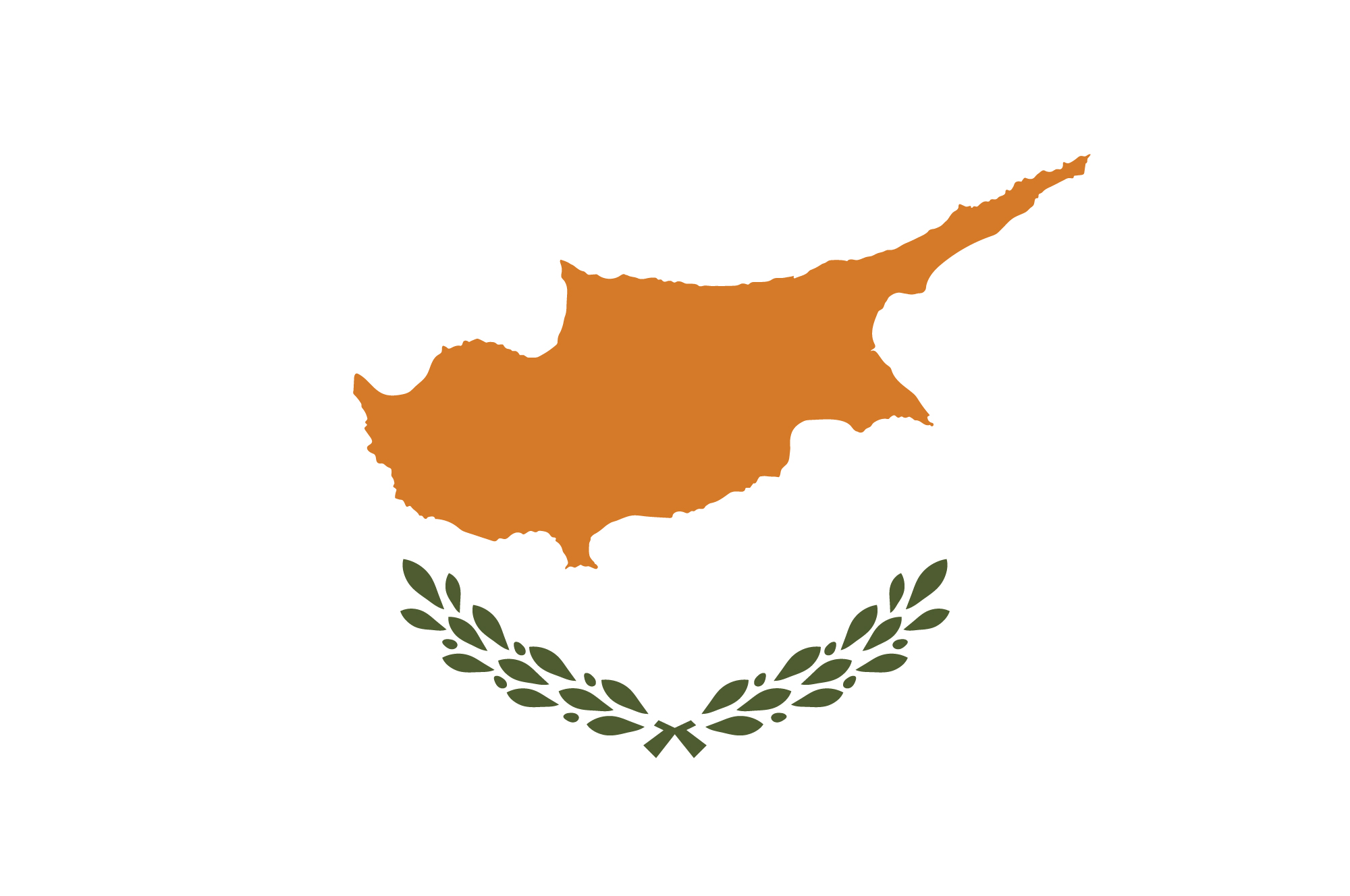Cyprus << SY pruhs >> is an island country in the northeastern corner of the Mediterranean Sea. It lies about 40 miles (65 kilometers) south of Turkey, 60 miles (95 kilometers) west of Syria, and 470 miles (760 kilometers) southeast of Greece. Geographically, Cyprus is part of Asia, but it is a member of the European Union (EU).

Cyprus is divided into two sections: the Republic of Cyprus and the self-declared Turkish Republic of Northern Cyprus (TRNC). The Republic of Cyprus, in the southern part of the island, is run by Greek Cypriots. The TRNC, in the north, is administered by Turkish Cypriots, though Turkey has some influence. All countries but Turkey recognize the Republic of Cyprus as the legal government of the entire island. Turkey is the only country that considers the TRNC an independent nation. The divided city of Nicosia—called Lefkosa in Turkish and Lefkosia in Greek—is the capital of both sections.

Cyprus lies on major trade routes between Europe, Asia, and Africa. It has been controlled by many groups throughout history. In 1878, it came under British rule. Cyprus became independent on Aug. 16, 1960.
The Constitution of Cyprus originally provided for the Greek and Turkish Cypriot communities to share governmental powers. But divisions and mistrust between the two groups led to violent clashes in the 1960’s. In 1974, after more fighting, Cyprus became divided into separate Greek and Turkish Cypriot sections.
Government.
A president, elected by the people for a five-year term, heads the government of the Republic of Cyprus. The president appoints members of the Council of Ministers. A one-house legislature called the House of Representatives makes the republic’s laws. The Supreme Court is the highest court.
The Constitution of the Turkish Republic of Northern Cyprus provides for a president to be elected for a five-year term. The president appoints a prime minister from the members of the Legislative Assembly. The Supreme Court is the highest court of the TRNC.

People.
About three-fourths of Cypriots live in the Greek Cypriot section. The majority of Greek Cypriots belong to the Orthodox Church of Cyprus, one of the Eastern Orthodox Churches. Most Turkish Cypriots are Sunni Muslims. Many Eastern Europeans have immigrated to southern Cyprus. Since 1974, many Turks have settled in the north. The large number of Turkish settlers in the north has been a major issue in reunification negotiations. The island’s population also includes small groups of Armenians, Maronites, and Roma.
In cities, most homes are constructed of cement blocks, concrete bricks, and stone. In some villages, the building materials include sun-dried mud bricks. Modern villas cover many coastal areas. Most urban homes have flat concrete roofs or slanted tile roofs.
People in most cities of Cyprus wear clothing similar to that worn in Europe and North America. Traditionally, men wore richly decorated vests and baggy black trousers called vraka in Greek and salvar (also spelled shalvar or shalwar) in Turkish. Women traditionally wore a short jacket called a sarka with a long skirt or loose trousers beneath a foustani, a pleated dress, or a saya, a long, narrow dress open in front and on the sides.
Greek and Turkish Cypriots enjoy many similar kinds of food. Many dishes are prepared with olive oil and contain meat mixed with vegetables. Favorite dishes include souvlaki (meat cooked on a long rod), stifado (beef stew), and kleftiko (roasted lamb). Other Cypriot dishes include afelia (braised pork with coriander), grilled halloumi cheese, and sheftalia (grilled minced meat). Popular beverages include beer, brandy, soft drinks, and wine. Cypriots also drink traditional sweet wines.
Greek is the primary language of the south, and Turkish the language of the north. The Cypriot dialects of both languages share many words. English is widely spoken by both communities.
Almost all adult Cypriots can read and write. Elementary and secondary education throughout the island is free. In the south, children from 6 to 15 years old are required to attend school. In the north, children from 7 to 15 years of age must attend school. The University of Cyprus, the University of Nicosia, and the European University Cyprus are three important universities in the south. The Eastern Mediterranean University in Famagusta is the largest university in the north.
Cypriots enjoy sports, especially soccer and swimming. They also relax by playing cards and backgammon and by taking family picnics to the beaches or mountains. Coffee houses are popular social gathering places.
Land and climate.
Two mountain systems dominate the landscape of Cyprus. The rugged Kyrenia range stretches along the northern coast. The Troodos Massif rises in the southwest. Parts of the Troodos Massif are thickly forested. Mount Olympus, the range’s highest peak, rises 6,403 feet (1,952 meters) above sea level. Between the two systems lie the Mesaoria and Morphou plains.
Cyprus has a pleasant, sunny climate. Snow falls high in the Troodos Massif early in the year. The plains have mild winters, but summer temperatures may rise above 100 °F (38 °C). Rainfall on the plains averages from 12 to 16 inches (30 to 41 centimeters) a year. Parts of the Troodos receive over 40 inches (100 centimeters). Rainfall in Cyprus has been decreasing since the late 1900’s.
Economy.
The Greek Cypriot section has a higher standard of living and a stronger economy than the Turkish Cypriot section. Greece and the United Kingdom are the chief trading partners of the Republic of Cyprus. Because the TRNC is not internationally recognized, foreign investors have traditionally been less interested in investing in the north. Turkey is the TRNC’s chief trading partner and supplies the TRNC with financial aid.
The economies of both sections of Cyprus depend on agriculture, manufacturing, and tourism. Leading crops include grapes, olives, oranges, and potatoes. Farmers also raise beef and dairy cattle, chickens, goats, hogs, and sheep. Factories produce cement, food and beverage products, machinery, and pharmaceuticals (medicinal drugs). Tourists visit the island’s mountain resorts, beaches, and archaeological sites. Banking, real estate, and other service industries are also important.
Cyprus has few natural resources. Copper has been mined for thousands of years. Cyprus also mines clay, gypsum, and sand and gravel.
International airports at Larnaca and Paphos serve the Greek Cypriot section. Larnaca and Limassol are the chief ports. Ercan (Tymbou in Greek), the Turkish Cypriot area’s main airport, only handles flights to and from Turkey. The main ports for the Turkish Cypriot area are Famagusta and Kyrenia. The Republic of Cyprus considers all northern ports and airports illegal.
History.
People have lived on Cyprus since about the 6000’s B.C. Greek settlers arrived on the island about the 1100’s B.C. Over the next 1,000 years, the Phoenicians, Assyrians, Egyptians, Persians, Macedonians, and Romans conquered Cyprus. Saint Paul and Saint Barnabas brought Christianity to the island shortly before A.D. 50.
When the Roman Empire split into two parts in A.D. 395, Cyprus became part of the East Roman, or Byzantine, Empire. From about the mid-600’s to the late 900’s, Muslim Arabs conducted a series of raids on the island. In 1191, King Richard I of England seized Cyprus from the Byzantine Empire and sold it to a Christian religious order called the Knights Templars. The following year, the Templars transferred control of the island to Guy de Lusignan, a French nobleman.
In 1489, Venice took control of Cyprus. In 1570 and 1571, the Ottoman Empire conquered the island. In 1878, the United Kingdom and the Ottoman Empire signed an agreement that allowed the British to administer Cyprus. The United Kingdom annexed the island in 1914, when the Ottomans joined the opposing side during World War I. Cyprus became a British crown colony in 1925.
The British introduced educational, administrative, social, and economic reforms. But they also encouraged divisions between Greek and Turkish Cypriots as a way of keeping the groups from uniting against British rule. Eventually, Greek nationalists called for enosis (union with Greece), and Turkish Cypriots demanded taksim (partition of the island into Greek and Turkish zones).
In the 1950’s, Greek Cypriots, under the leadership of Archbishop Makarios III, started an active campaign for enosis. A Greek Cypriot secret organization called EOKA began attacking the British—and later Turkish Cypriots who helped the British. The British declared a state of emergency in 1955 and exiled Makarios in 1956. The crisis contributed to the deterioration of relations between Greece and Turkey and the two Cypriot communities.
Greece, Turkey, the United Kingdom, and leaders of the two Cypriot communities signed the Zurich-London Agreements in 1959. The agreements granted Cyprus independence on Aug. 16, 1960, and stated that Greece, Turkey, and the United Kingdom could act together or separately to prevent either enosis or taksim. The United Kingdom retained two military bases on the island.
The 1960 Constitution provided for a Greek president and a Turkish vice president, each elected by their respective communities. Makarios became president. In 1963, he suggested 13 proposals for amending the Constitution, arguing that they would result in better administration of the country. Turkey and the Turkish Cypriot leaders opposed the changes, arguing that the changes would eliminate many of the Turkish Cypriots’ rights.
Fighting broke out between Greek and Turkish Cypriots. The violence ended Turkish Cypriot participation in the Cyprus government in 1963. In 1964, the United Nations (UN) sent a peacekeeping force to Cyprus. In 1967, the two groups clashed again, and the Turkish-controlled areas set up new, separate governing bodies.
On July 15, 1974, Greek officers, with the support of the military leaders ruling Greece, overthrew Makarios. On July 20, Turkey sent troops to Cyprus to prevent what it saw as a Greek attempt to unite Cyprus with Greece. Widespread fighting occurred between the Turks and Greek Cypriots, and the Turks captured large amounts of territory in northeastern Cyprus. A cease-fire was declared in August. About 180,000 Greek Cypriots and 45,000 Turkish Cypriots were displaced. Since then, the Turkish and Greek Cypriot areas have been divided by a buffer zone called the “green line” or “Attila line.” UN peacekeeping troops patrol the zone today.
Representatives of the Greek and Turkish Cypriots, and of Greece and Turkey, have met off and on since 1974 in an effort to reach new constitutional arrangements for all of Cyprus. But strong disagreements over control of the country have remained.
In 1975, Turkish Cypriot leaders declared the northeastern territory an autonomous (self-governing) region called the Turkish Federated State of Cyprus. In 1983, they unilaterally declared the territory an independent nation called the Turkish Republic of Northern Cyprus.
In 1998, Cyprus began a formal process toward becoming a member of the European Union (EU). The EU is an organization of European countries that promotes economic and political cooperation among its members. The prospect of EU membership triggered UN-led reunification talks in 2002 and early 2003 between Greek Cypriot and Turkish Cypriot leaders. However, the two sides failed to agree on a peace plan. In April 2003, the Turkish Cypriot government lifted restrictions on travel across the green line. This move allowed both Greek and Turkish Cypriots to cross the line for the first time since the island’s division in 1974.
In May 2004, after failed efforts at reunification, Cyprus formally joined the EU. However, the benefits of EU membership applied primarily to the Greek Cypriot section of the island. The north is part of the EU, but it cannot initiate direct trade or flights to other countries. The EU’s laws do not apply there.
In February 2008, the Republic of Cyprus elected moderate Demetris Christofias president. In April, a major crossing between Greek and Turkish Cypriot Nicosia opened. That same year, Cyprus—along with much of Europe—began suffering from a sharp economic downturn. In February 2013, voters elected center-right candidate Nicos Anastasiades as the new Cypriot president. In March, facing economic collapse, Cyprus accepted a 10-billion-euro ($13-billion) emergency loan offered by the countries that use the euro and by the International Monetary Fund (IMF). Voters reelected Anastasiades in 2018. Former foreign minister Nikos Christodoulides succeeded Anastasiades as president after elections in 2023.
Increasing numbers of migrants from Africa and the Middle East came to Cyprus in the early decades of the 2000’s. Crowded refugee camps housed people fleeing conflicts in Syria, Cameroon, and other countries.
